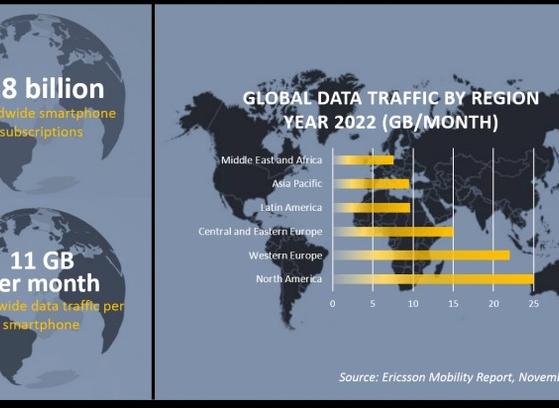Sun Tzu in The Art of War offers a specific strategy for success — “winning without conflict”. It proposes using your unique position to discover opportunities, while turning opponents' apparent strength against them; the smartest rather than the strongest will win in this game. To be the smartest though you need to be able to make the wisest choices, and to do this you need a holistic understanding to inform actionable decisions that could mean the difference between success and failure.
 Communication service providers (CSPs) are under increasing pressure to transform and adapt to ensure they deliver the quality they promised their customers. Unfortunately the environment is demanding and dynamic, and the introduction of new devices and applications are unpredictable while accelerating. To add fuel to the fire, revenues in traditional markets are declining, margins are being squeezed and thanks to the advent of smartphones and over the top (OTT) applications, data usage is placing unprecedented demands on their networks. Data is considered table stakes which increases the challenge to differentiate. Also, many of the technologies being deployed to support IP switched traffic pose challenges CSPs have not seen before.
Communication service providers (CSPs) are under increasing pressure to transform and adapt to ensure they deliver the quality they promised their customers. Unfortunately the environment is demanding and dynamic, and the introduction of new devices and applications are unpredictable while accelerating. To add fuel to the fire, revenues in traditional markets are declining, margins are being squeezed and thanks to the advent of smartphones and over the top (OTT) applications, data usage is placing unprecedented demands on their networks. Data is considered table stakes which increases the challenge to differentiate. Also, many of the technologies being deployed to support IP switched traffic pose challenges CSPs have not seen before.
Communications service providers need to face up to the following challenges:
- Decline in revenue and increased demand — changes in market dynamics and increased market entry from non-traditional competition.
- Operational challenges — increased network and service complexity services, such as long term evolution (LTE) for example, offer their own challenges, however deployment of voice over LTE (VoLTE), whilst it has anticipated benefits such as technology efficiency and voice quality, also embodies significant complexity due to the addition of multiple components that need to be considered.
- Accelerating changes in consumer behaviour — adoption of smartphones instantly changed consumer behaviour and the consumption of services which resulted in decreased loyalty towards traditional communication service providers.
Anticipating declining revenues in a saturated market where penetration is > 100%, communication service providers realise they need a different strategy to secure sustainable growth. It is therefore little surprise that for many, customer retention underpinned by a superior customer experience is a strategic priority. However, without a multidimensional end-to-end view of Quality of Experience (QoE), involving true experience, any effort is deemed hopeless.
Customer satisfaction is a critical long term strategy. Since CSPs no longer control the end-to-end delivery of their services, achieving quality of service (QoS) alone no longer secures differentiation. Customer perception is increasingly dependent on independent factors such as services offered by external providers and devices. Acquisition of new customers is difficult for two reasons: first, it is expensive and second, commoditised communications service offerings are increasingly hard to separate. Superior customer experience underpinned by an end-to-end understanding of true QoE is the new differentiator.
QoE is multi-dimensional by nature and CSPs therefore need to bring all aspects together across the network, control and user planes, including individual user level detail such as who (user profile), when (time of day), where (geo-location) and what (device/application).
CSPs can realise the following benefits by implementing this strategy.
- Improve Customer Experience and reduce churn
By making end-to-end QoE the key enabling pillar of their customer retention strategies, CSPs can provide a consistent and superior QoE on a per-service, per-user basis, thereby providing a better platform to enhance customer experience and improve customer retention. - Improve operational efficiency
CSPs can streamline processes and prioritize actions in customer care, network operations, service operations, network planning and engineering. - Targeted network optimization and next best network investment
Analysis of end-to-end QoE provides CSPs with an experience-centric insight to supplement the traditional network performance KPIs, enabling them to make better decisions on network optimization (e.g. indoor vs outdoor) and network investment strategy (e.g. Wi-Fi build-out vs RAN expansion).
Table 3.2: Benefits of holistic QoE assurance
Traditional service assurance centred around network centric metrics and QoS has drawbacks, such as real time analysis of QoE, or performance in terms of appropriate dimensions, which prevents critical issues form being quickly discovered and resolved. To address this, CSPs are increasingly moving towards service quality management (SQM) approaches which correlate key performance indicators (KPIs) such as latency, jitter, etc. to derive service key quality indicators (KQIs) pertaining to the accessibility, retention, integrity and mobility of services. Even though SQM is a step in the right direction, such systems still lack broader contextual factors that influence QoE.
Embracing a multi-dimensional QoE-based approach requires moving beyond the network and towards management of both service quality and customer experience:
- Harnessing data from a diverse set of sources
- Enabling CSPs to aggregate, correlate, contextualise and analyse the varying data from diverse sources
- Producing insights that can be visualised in different forms while driving a range of use cases at various levels relevant to multiple technical or business focused stakeholders.
- Facilitating,for example, the improving agility of processes in the network operations centre (NOC) or the services operations centre (SOC).
QoE also enables micro-segmentation which, instead of using traditional demographics, groups people based on application usage, device usage, and location, so customer care, propositions and service can be personalised on a user profile.
Example of Use Cases that Demonstrate the Value of Holistic QoE
Assuring QoE for VoLTE
VoLTE. the voice service delivered over all-IP LTE networks .is being deployed. Many are positioning VoLTE as having superior quality, especially in competition with OTT providers, such as Skype, Whatsapp and Viber, in offering a best effort. CSPs are therefore under pressure to supersede expectations derived from traditional circuit switched voice.
On the other hand, the inherent technological complexities of VoLTE bring new challenges such as call handover between LTE, 2G/3G and legacy circuit switched, potential signalling overload in the core, and increased network performance requirements. Due to the voice service being real-time in nature, any degradation in network performance can have a noticeable impact on call quality, so the network must be optimally tuned (e.g. QoS class identifier) to ensure that voice packets get the highest priority, with a guaranteed bit rate. Some of the network KPIs such as bit rate, latency, jitter and packet loss — which are the inputs for the measurement of voice quality — must be monitored and actioned in real time.
By enriching data on network performance and voice quality with contextual information, such as the location of the call, CSPs can identify the location of RAN issues, such as interference, with pinpoint accuracy. Additionally, further data enrichment such as customer identity (e.g. the customer's IMSI, whether they are a low-value customer or a high-value VIP) allows for the prioritization of actions; for example, CSPs can focus on high-value customers as a priority. Such a multi-dimensional and proactive approach to end-to-end QoE assurance enables CSPs to trigger troubleshooting workflows and resolve problems before they impact customers' experience, preventing calls to customer care.
Targeted RAN Optimization Based on Geo-Location, Application and Financial Metrics
Mobile CSPs are under significant pressure to increase network capacity and better allocate and optimize network resources to support the rising rate of mobile data consumption. CSPs have traditionally used network planning and optimization software to add the appropriate capacity in the right place at the right time without expensive overbuilds. However, this is largely an offline process that does not take into consideration other factors such as financial KPIs and app performance metrics. How can CSPs extract the biggest ‘bang for their buck' by optimizing the use of existing network resources, while providing the latest services at the highest possible quality levels?
By correlating the app performance data with the location intelligence, CSPs can determine what throughput the top data apps are receiving by location. By further linking subscriber-level commercial data, such as ARPUs, CSPs can accurately visualize where subscribers are spending their time and what types of apps they are accessing. CSPs can then prioritise immediate follow-up actions to optimize the RAN to ensure that high-value subscribers get the best QoE.
To further illustrate this use case, consider a scenario where four sites have been identified as having a congestion problem, all requiring remedial action such as traffic offload. How can the CSP decide which site should be given priority? The app-aware capability can provide deeper insight into the characteristics of the apps being used at each site. In this example, three sites may be shown to be dominated by low-value traffic and customers, while the fourth may be carrying high-value traffic; the CSP can then prioritize the fourth site over the other three for traffic offload.
Examples of other variants of this use case are:
- Identifying cell sites for technology upgrades, or ‘next best investment' of network capex, based on revenue per site and customer location access points.
- Initiating targeted marketing campaigns based on customer context and location.
- Enabling proactive customer care by pre-empting calls to the contact center.
Assuring QoE for Video
It is now widely accepted in the telecom industry that video is the new killer app. Video accounts for the majority of data traffic that traverses communications networks, and most forecasts predict that video will account for about two-thirds of mobile data traffic by 2020. Furthermore, with the increasing adoption of multi-screen video services, a diverse set of consumer devices will drive different consumption patterns, with varying QoE expectations. It is therefore essential for CSPs to implement a robust QoE assurance strategy that takes into consideration the multiple facets of video service delivery, such as the nature of video application (e.g. YouTube or Netflix) and the type of device used for service consumption (e.g. tablet, PC, IPTV or smartphone).
Scenario Where a Customer Suffers Poor QoE Due to low-quality Wi-Fi service.
Using location intelligence and app awareness, together with data from instrumentation on the consumer's device, the CSP can isolate the issue and identify a resolution which improves the QoE of the video service and enhances the customer's experience.
Conclusion and Recommendations
In the rapidly changing mobile services landscape, CSPs must make customer retention the basis for their long-term sustainable growth, and use a strong competitive differentiator to support this strategy. A multi-dimensional QoE approach to monitoring and assuring the customer's service quality can be the differentiator. Only a holistic QoE approach provides a true end-to-end view of the service, enabling CSPs to prioritize follow-up actions to improve service quality and overall customer experience. A unified QoE approach should consider the following six aspects:
- End-to-end network performance, including the end device, access (RAN, Wi-Fi, small cells), core network, and the application servers.
- Customer's geo-location (where and when?).
- The app or service accessed by the customer (what?).
- The customer's identity (who?).
- The device being used.
- The time period of usage.
For highest impact, CSPs must consider implementing use cases that takes into account all six aspects. Assuring VoLTE, targeted RAN and HetNet optimization, as well as video QoE, are some examples that the CSPs can consider.











